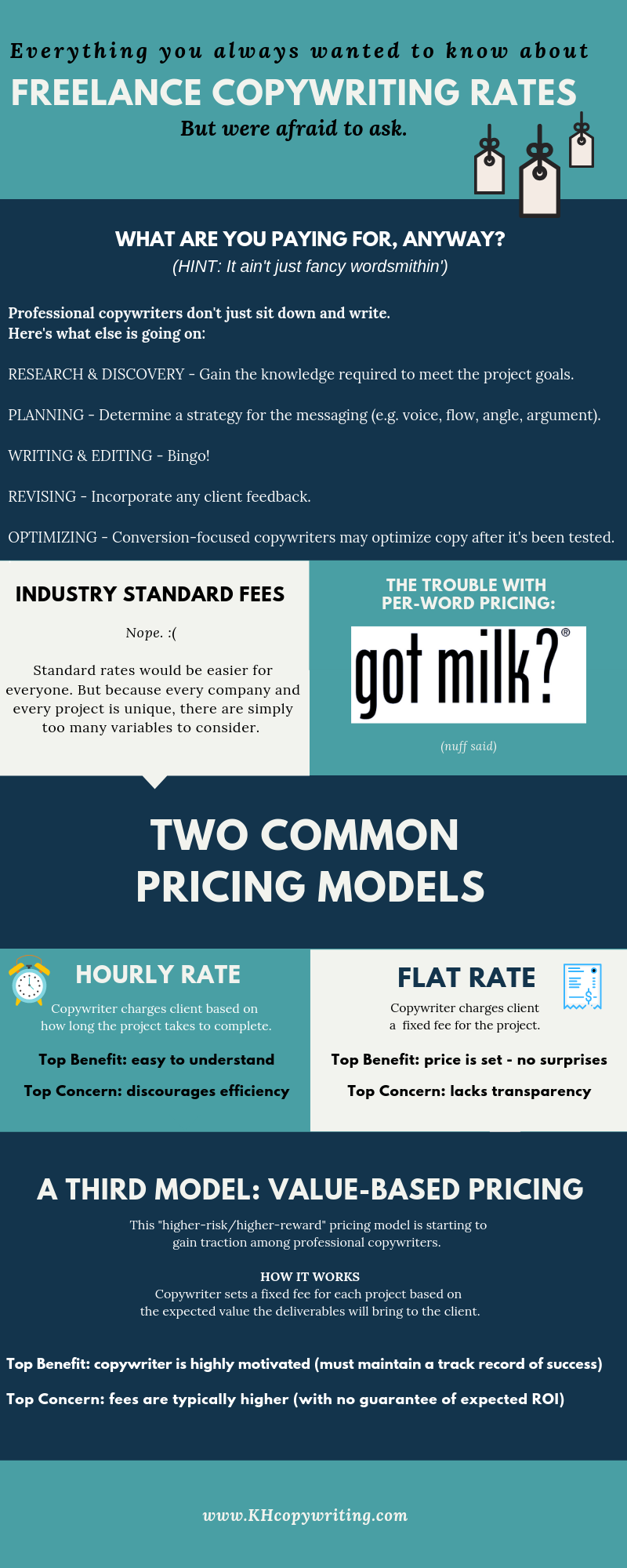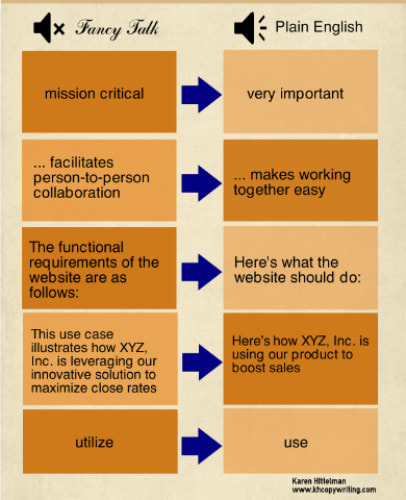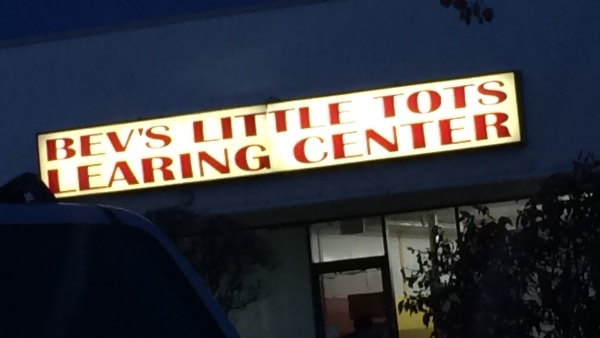Everything you always wanted to know about freelance copywriting rates, but were afraid to ask4/18/2019
1 Comment
The other day as I was reviewing a new client’s web copy, I saw the header, “We Think Outside the Box” – big and bold on the About page. Turns out, the copy had been there for many years without being updated (the reason I was reviewing it in the first place). It happens. But still. Oy! Seeing those words inspired me to make the following public service announcement: If you have the words “think outside the box” anywhere on your company website or in any of your old (or, God forbid, new) marketing materials, or if you ever use the phrase in conversations or presentations . . . or at all, ever—I implore you to cease and desist. The once-inspired phrase has run its course. At this point, saying it simply proves the opposite. It’s like posting on all your social media accounts, “I’m incredibly humbled to announce I’ve been named Greatest Person on Earth!!!” It’s verbal hypocrisy. Borrowing a nice turn of phrase isn’t a bad thing (unless there are trademark/copyright issues). In marketing, we all do it. I read an interesting article on NPR’s All Songs Considered about whether all the great song ideas have already been used up. I think the analysis applies to marketing, too (strange as that may seem). Here’s a snippet: "Depending on how you define newness, everything and nothing qualifies . . . As much as novelty can excite and inspire, so can familiarity; so can universal truths; so can old things said in unexpected ways, by newly amplified voices with fresh perspectives." I’m always on the lookout for a great turn of phrase. The Notes app on my iPhone is full of words and phrases that I see or hear and may want to use at some point (either for my work or just to throw nonchalantly into conversation). The problem, of course, is that a particularly catchy catchphrase can catch on fast—especially in the marketing world. And once everyone starts using it, it loses its oomph. The trick is being able to understand when a trendy “new” word/term/phrase has been so overused that it’s lost its potency. “Think outside the box” is an extreme and obvious example. But not all instances are so easy to determine. As with milk, that expiration date can really sneak up on you! Here are three examples of worn out marketing terms I’m trying to stop using:
It's tough to create a strong white paper on the cheap. The writing phase often requires research, SME interviews, and strategic planning—and copywriting fees can reflect that. Once you add in graphic design and layout, you’re looking at what might seem like a big investment for a single piece of content.
But for tech companies and other businesses that sell high priced solutions and services, the return on that investment can be huge. A well-researched, well-written white paper (on a relevant and important business issue!) can help convince scrupulous prospects to make big purchases. It can give IT teams the ammo they need to get leadership buy-in. It can help differentiate your company and position your leaders as experts. And at the top of the marketing funnel, a white paper can alert and educate prospects about an emerging business issue they should be looking to address. A good white paper is a terrible thing to waste; milk it for all its worth*. Rather than developing a white paper as a standalone piece, why not surround it with a powerful posse of complementary content? Develop accompanying content that promotes your white paper; dives deeper into key themes; highlights experts; and sparks new discussions. Here are six examples:
*What's the correct way to write this phrase? Is it "for all it's worth" (contraction: milk it for all it is worth) or "for all its worth" (possessive: milk it for the inherent worth within it)? There doesn't seem to be a definitive answer, and now I can't stop obsessing about it. Which way do you think is correct? "I want to be a B2B technology copywriter when I grow up!" -- said no kid ever. Not many adults think of copywriting as a dream job, either. At a cocktail party, the conversation generally goes something like this:
Random party guest: “What do you do for a living?” Me: “I’m a freelance copywriter, and I work mainly with technology companies.” RPG: “Wow! You must see so many cool futuristic inventions. Where’d you go to law school?” Me: “Sorry -- no, I’m not a copyright lawyer. I’m a marketing writer. RPG: “Oh… so you write ads and stuff?” Me: “Not exactly. Most of my clients are technology companies, and I work with them to create all types of content to help them market their products and servi ---.” RPG: “Zzzzzzzzzzzzz….” I know. I should come up with a more “attention-grabbing” explanation of what I do. Believe me, I’ve tried. I keep telling myself that next time the opportunity arises, I’ll just say, “I’m an ice sculptor.” And see where that takes the conversation. If you’re reading this blog, however, you already understand what a copywriter is. With that part out of the way, I can finally cut to the chase and explain WHY being a “copywriter-that-specializes-in-tech-marketing” really is a great career that kids should aspire to be when they grow up. 5 reasons to be a copywriter-specializing-in-technology-marketing:
I launched my “90-Second Newsletter” last year, figuring it would be a nice, unobtrusive way to stay in touch with my clients and other professional contacts.
At the one-year anniversary of my first newsletter publication, I decided to review the stats. Turns out, not all of my subscribers are reading my newsletter consistently (36.4% average open rate). I get that. In fact, when it comes to emails, I consider the “Trash” button one of my most effective productivity tools. But here’s what surprised me. Despite the fact that only a third of my subscribers actually opens my newsletter each month, my client relationships have blossomed. In 2017, I had more consistent work from my regular clients and more new work from dormant clients and prospects than ever before. I’m confident my newsletter had a lot to do with that. Here are two things I think are at play: 1. When clients and contacts see my newsletter in their inbox every 4-6 weeks, my name becomes more familiar them. So when they need a copywriter, they think of me without having to search through files and old emails. Translated into marketing lingo: Newsletters increase brand awareness. 2. When subscribers actually open (and possibly even read) my newsletter, our relationship grows. With each newsletter, my clients and professional contacts get a glimpse into who I am—as a person and as a writer. Translated into marketing lingo: Newsletters build relationships and trust with customers and prospects. HIGH-LEVEL TAKEAWAY: When it comes to marketing tactics, newsletters don’t get nearly the credit they deserve*. *Clearly, my one-newsletter sampling does not provide rock solid data for this conclusion, but I’m sticking with it nonetheless. updated Believe it or not, copy written about technology CAN be easy to read and understand. Here's the key: Use words people know, and kick the geek-speak and marketing mumbo-jumbo to the curb (notice I didn't say, "Laymanize the manuscript"). Of course, the main thing is to know your audience. If you're writing a brochure to promote all the killer iPhone games your company has created, and you'll be handing it out at YodaCon2017: The Mobile App Design and Development Expo, feel free to mention objective-c and XCode; talk about your adherence to scrum methodology; or explain how your engineers use plists to make your games more data driven and flexible. Otherwise, stick to plain English. How many times have you read the homepage of a company's website and come away without understanding what, exactly, it is they do? Cloud computing companies come to mind, but it happens all the time, in every industry imaginable. Often, the problem stems from a desire to come across as a smarty pants ... I mean ... a thought leader. But heavy use of industry jargon and highfalutin language isn't smart; it's distracting. Just say it!
If your fiscal year ends on December 31, you may be suffering from one of the following marketing maladies:
Either way, you’re under pressure to make the most of your remaining budget. Here are 9 year-end projects to consider:
A couple months ago, I noticed a typo on a storefront sign in a strip mall. It struck me as hilarious at first, so I snapped a photo (see above). But I kept thinking about it on my drive home.
By the time I got to my house, I was feeling bad for Bev. I’m guessing she must have become aware of the typo at some point over the years (I mean, the sign was definitely not new), but just didn’t have the money to get a new one. Why else would it still be up there, all lit up? For a learning center, misspelling any word—and in particular, the word “learning”—can’t be good for business. Especially when the word is part of the business name. It doesn’t help that the misspelling sounds like “Leering.” Not a word you want to associate with Little Tots. But you know what they say: Nothing is certain but death and taxes. And typos. (Happy Tax Day, by the way.) As a copywriter, I wish I had a foolproof system for avoiding typos. But I don’t. Many of my clients have a proofreader in-house. Others use third-party proofreading services. But if you’re creating content and proofing it yourself, I’ve got a 4-step process that works pretty well. Check it out: Step 1: After you’ve finished writing the copy, walk away from it for at least 2 hours before proofreading. If you can put a full day between yourself and the copy, that’s even better. Step 2: Enlarge the text to grandma size (like a 15 pt. font), and read the copy one time through on your computer – aloud. Step 3: Print out a hard copy of the text, and read through it again—word by word—using a pen to physically touch every single word and punctuation mark as you read. Step 4: Take a 15-minute break, and then read the copy one more time – aloud, at normal speed. Did you know 2017 has been dubbed “The Year of Video Marketing”? I have to admit, although I'd noticed more and more companies jumping on the video bandwagon, I didn’t realize the tactic had captured the “Year of…” crown. So I did some investigating. And I found a plethora of stats—in blogs, articles, reports, and (in total meta fashion) videos—all abuzz about the power of video as a B2B marketing tool. Here’s a smattering of what I found:
Wowza! As a copywriter, I couldn’t be happier about the potential this brings for more fun projects. Because I've been into scripts and scriptwriting since back in the day. Long, long ago, before B2B copywriting was even a twinkle in my eye, I spent a couple freewheelin’ years of my youth as an actress and scriptwriter in Hollywood. Okay, I’m making it sound way more romantic than it was. But as a card-carrying member of the Screen Actors Guild, I understand the importance of good scripted dialogue. And I did spend a year under the mentorship of a successful screenwriter, writing the screenplay for a romantic comedy, which tragically never got made, thanks to Madonna! But that's a story for another time. For now, I’ll just leave you with one final statistic: Using the word “video” in an email subject line boosts open rates by 19% and increases click-through rates by 65%. You know the scenario. You’re sitting in a café, waiting for a friend or a client to arrive. Before you even take a sip of your latte, you pull out your smartphone. You don’t need it for any particular reason, you just reach for it out of habit. It gives you something to do while you wait (actually, it gives you lots of things to do while you wait). Gone are the days of coffee and cigarettes; now it’s coffee and smartphones.
Our addiction to smartphones is powerful and pervasive. And of course, our growing use of mobile technology isn’t confined to coffee shops. It’s everywhere. With mobile search now surpassing desktop search, more and more businesses are scrambling to implement mobile marketing strategies. For many, the first step is to optimize the company website for mobile viewing, ensuring that pages load quickly, navigation is smooth, and content fits the mobile screen. Getting visitors to stay on the site, and not click away because it’s just too hard to view, is the first hurdle. The next is to ensure all content on the mobile website is clear, engaging, and relevant to target customers. If smartphones are the new cigarettes, content is the new nicotine. Its potency is what keeps customers coming back for more. |
|











 RSS Feed
RSS Feed